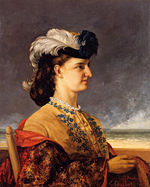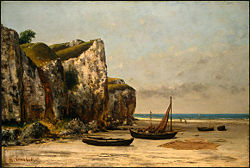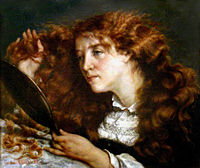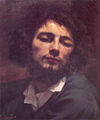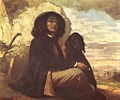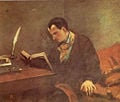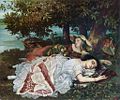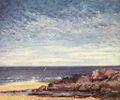Courbet, Gustave
David Doose (talk | contribs) m |
|||
| Line 1: | Line 1: | ||
| − | {{epname|Courbet, Gustave}}{{claimed}} | + | {{epname|Courbet, Gustave}}{{claimed}}{{Started}} |
::''For the French Admiral, see [[Admiral Courbet]] (1828-1885)'' | ::''For the French Admiral, see [[Admiral Courbet]] (1828-1885)'' | ||
{{Infobox Artist | {{Infobox Artist | ||
Revision as of 02:08, 7 December 2007
- For the French Admiral, see Admiral Courbet (1828-1885)
| Gustave Courbet | |
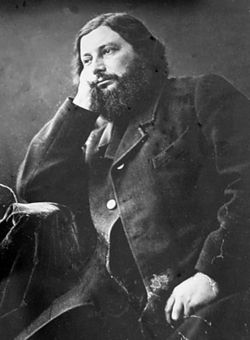 Gustave Courbet (portrait by Nadar). | |
| Birth name | Jean Désiré Gustave Courbet |
| Born | 1819-06-10 Ornans, France |
| Died | 1877-12-31 La Tour-de-Peilz, Switzerland |
| Nationality | French |
| Field | Painting, Sculpting |
| Training | Antoine-Jean Gros |
| Movement | Realism |
| Famous works | Burial at Ornans (1849-1850) L'Origine du monde (1866) |
Jean Désiré Gustave Courbet (10 June 1819 – 31 December 1877) made a living painting the varied scenes everyday life in France. The very nature of his subject matter established his reputation as one of the leading artists of mid-19th century Realism.
From Courbet's early days as a painter, he was recognized. Whether his art shocked or intrigued the viewer, the public was paying attention to France's latest talent. It is unusually to create masterpieces at the beginning of a career, but in 1849 and 1850 Courbet produced two paintings that are critically acclaimed as his best work. They are The Stone-Breakers and Burial at Ornans. With these paintings, Courbet secured a reputation for being different from the popular paintings completed in the Neoclassic and Romantic genres. His paintings exhibited less controlled brush strokes and more fluidity of movement.
Courbet wasn't only a painter, he was a political painter. This means that he used his realistic paintings of peasants to promote his socialist view of the world. His political beliefs were influenced greatly by the life and teachings of Pierre-Joseph Proudhon. While socializing in various artistic and literary circles in Paris Courbet made several friends, including Charles Baudelaire and Champfleury.
Early Life
Gustave Courbet was born in the city of Ornans on June 10, 1819. Courbet grew up under the influence of his temperamental father, a prominent landowner of the region. Courbet seems to have had no qualms about stating his opinion and showing disregard for those who did not agree with him. The boy often saw many scenes of peasantry and local life in the Franche-Comté region in which he grew up. When Courbet turned 18, he left home to pursue an education at the Collège Royal at Besançon. Although he didn't plan on becoming a painter by profession, he pursued his interest in it though study.
At the Collège Royal, the techniques and methods used came under Courbet's testy scrutiny. He disliked the classical and formalistic methods and subjects the college focused on. In fact, he became so convincing in his argument against the college, that he found students to join his ranks and he led a revolt.
While studying at the college, Courbet made friends with the aspiring writer, Max Buchon. When Buchon's Essais Poétiques (1839) were being published, he commissioned Courbet to illustrate it. Courbet obliged by creating four beautiful lithographs for the work. Also during his studies, he enrolled as an externe, thus he could not only attend classes at the college, but he was also able to take classes from Charles Flajoulot at the école des Beaux-Arts.
Following the education he received, Courbet left the college and moved to Paris in 1840. Here he decided to begin an intense study of the law, however he quickly changed his mind and realize that his true life's calling led him to painting. He spent hours upon hours copying various paintings in the Louvre. His first major breakthrough happened in 1844 with his painting, Self-Portrait with Black Dog. His painting was selected for a showing at the Salon.
The next year Courbet upped his submissions with five paintings, however, only one was selected, it was Le Guitarrero. The year after this, all of his paintings were rejected. But in 1848, the Liberal Jury eased his anger, recognized his talent, and took all 10 of his entries. The harsh critic Champfleury apologized profusely to Courbet, praised his paintings, and began a friendship.
Realism
Gustave Courbet is often given credit for coining the term Realism. He was innovative in the movements creation, his art fed its rapid growth, and several other artists were soon dubbing themselves "realists".
Courbet's landscapes and seascapes were know for their figurative compositions. His art traversed the topics of peasant life, poor working conditions, and abject poverty. Because of his attention to such subject matter, Courbet never quite fit into the other artistic categories of Romanticism or Neoclassicism. Courbet felt that these schools of art were not concerned in the pursuit of truth. He truly believed that if his paintings could realistically and truthfully capture the social imbalances and contradictions he saw, then it would spur people to action. His grad portrayal of the harsh realities of life led to much criticism from those who preferred only beauty in their art. He didn't mind the critiques, in fact, he was proud to adopt a cult of ugliness.
Courbet was a perfectionist. This carried over into the characteristics that defined realism. Realists were concerned with trueness of line and perfect forms. However, they also embraced a type of roughness when dealing with the paint. They understood that nature, itself, was not perfect, and thus the paintings should reflect the irregularities noted. Thus, with similar artists such as Honoré Daumier and Jean-François Millet, the idea and form of Realism was invented in France.
Courbet also found influence after a trip to the Netherlands introduced him to the works of Rembrandt, Hals, and the other Dutch masters of the time period. He appreciated their honest portrayals of life.
Courbet often met with simultaneous praise and rejection from art critics. But, by 1849 Courbet was too well known to be able to be denied the showing of his work. He continued to produce art such as After Dinner at Ornans (for which the Salon awarded him a medal) and The Valley of the Loire.
Burial at Ornans
The Burial at Ornans has long been considered Courbet's greatest work. He recorded an event which he witnessed during the fall of 1848, the funeral of his grand uncle. Artists before him who painted real events often used models in recreating the scene. But Courbet, true to his calling as a realist, said that he "painted the very people who had been present at the interment, all the townspeople". This painting became the first realistic presentation of the townspeople and their way of life in Ornans.
The painting was enormous. It measured 10 by 22 feet (3.1 by 6.6 meters) and portrayed something that was thought prosaic and dull: a simple funeral. But viewers were even more upset because paintings of this size were only ever used to depict royalty or religion. With the birth of this painting, Courbet said, "The Burial at Ornans was in reality the burial of Romanticism."
The Salon of 1850 found him triumphant with the Burial at Ornans, the Stone-Breakers (destroyed in 1945), and the Peasants of Flagey. Other figurative works, with common folk and friends as his subjects, included Village Damsels (1852), the Wrestlers, Bathers, and A Girl Spinning (1852).
Courbet finally found an audience ready to accept the combination of realism and socialism. To add to his paintings, Courbet also penned several politically charged essays and dissertations.
To a friend in 1850 he wrote,
| “ | ...in our so very civilized society it is necessary for me to live the life of a savage. I must be free even of governments. The people have my sympathies, I must address myself to them directly.[1] | ” |
In 1855, one of his most important paintings The Artist's Studio was displayed. The painting depicts an an allegory of Courbet's life as a painter. He illustrates it as quiet a heroic venture, one in which his friends and admirers surround him. One such friend portrayed in the painting was Charles Baudelaire.
Notoriety
Courbet continued to stun his public by the subject matter he chose. He went from funerals to painting that was much more erotic. In the late 1860s, Courbet created a series of paintings he titled The Origin of the World (L'Origine du monde). Here people were shocked to see close up paintings of female genitalia, and The Sleepers (1866), depicting two women sharing a bed.
On 14 April 1870, Courbet established a "Federation of Artists" (Fédération des artistes) to promote the uncensored production and expansion of art. The group's members included André Gill, Honoré Daumier, Jean-Baptiste Camille Corot, Eugène Pottier, Jules Dalou, and Édouard Manet.
At a time of political upheaval, Courbet refused the cross of the Legion of Honour offered to him by Napoleon III. This served to increase his popularity among those who were against Napoleon. And in 1871, the Paris Commune gave Courbet charge over all of the Paris art museums. It was Courbet who saved these masterpieces from the looting and frenzied mobs. He took part in more ways than one, Courbet insisted on executing the Cummunal decree that called for the destruction of the Vendôme Column. The destruction took place, he was held responsible and was sentenced on 2 September 1871 by a Versailles court martial to six months in prison and a fine of 500 francs.
The problems with the column did not go away after that. In 1873, the newly elected president Mac-Mahon wanted to resurrect the Column, and he choose Courbet to pay the expenses. Courbet was forced to take refuge in Switzerland to avoid bankruptcy. On 4 May 1877, the estimate of the costs was finally established: 323,091.68 French francs. Courbet did not get out of the fees, but was allowed to pay the fine in yearly installments of 10,000 francs for the next 33 years, until his 91st birthday. However, the payment was never received.
Gustave Courbet died at age 58, in La Tour-de-Peilz, Switzerland. The cause of death was liver disease aggravated by heavy drinking. His death occured on 31 December 1877, a day before the payment of the first installment was due. (Bernard Noël, 1978) An exhibition of his works was held in 1882 at the École des Beaux-Arts.
Legacy
Gustave Courbet was influential in many regards. First, he broke the mold of convention with his revolutionary ideas and techniques. This, in turn, lead to the creation of a new art movement, that of Realism. These important contributions to the world of art opened the path for many to follow. He is often credited with inspiring the Impressionist painters, in particular Manet (the father of Impressonism). [2]
The paintings of Courbet continue to be visited by thousand of fans. His works hang in galleries throughout France and the United States. The Metropolitan Museum has more than 20 of his works.
Gallery
- Frauen beim Getreidesieben.jpg
The Grain Sifters (1854).
Notes
- ↑ Courbet, Gustave: artchive.com citing Perl, Jed: Gallery Going: Four Seasons in the Art World, 1991, Harcourt, ISBN 978-0151342600.
- ↑ Gustave Courbet and Realism Redflag.org.uk. Retrieved November 28, 2007.
ReferencesISBN links support NWE through referral fees
- Nochlin, Linda, Courbet, (London: Thames & Hudson, 2007 ISBN 978-0-500-28676-0)
- Champfleury, Les Grandes Figures d’hier et d’aujourd’hui (Paris, 1861)
- Mantz, "G. Courbet," Gaz. des beaux-arts (Paris, 1878)
- Zola, Émile, Mes Haines (Paris, 1879)
- Lemonnier, C, Les Peintres de la Vie (Paris, 1888).
- Noël, Bernard, Dictionnaire de la Commune (Paris: Champs Flammarion, 1978)
- Nochlin, Linda, Realism: Style and Civilization (New York: Penguin, 1972).
- This article incorporates text from the Encyclopædia Britannica Eleventh Edition, a publication now in the public domain.
External links
- General
- Courbet images and biography at CGFA
- Artchive on Courbet
- Humanities Web on Courbet
- Art Renewal Center; biography and images
- Articles and essays
- "The history of 'The Origin of the World'": an article in the TLS by Mark Hutchinson, August 8th 2007
- Courbet’s Low Tide at Trouville in the Walker Art Gallery, Liverpool
- E-zine article on Gustave Courbet
- 1867 Caricature of Gustave Courbet by André Gill
- smARThistory: Young Women from the Village
Credits
New World Encyclopedia writers and editors rewrote and completed the Wikipedia article in accordance with New World Encyclopedia standards. This article abides by terms of the Creative Commons CC-by-sa 3.0 License (CC-by-sa), which may be used and disseminated with proper attribution. Credit is due under the terms of this license that can reference both the New World Encyclopedia contributors and the selfless volunteer contributors of the Wikimedia Foundation. To cite this article click here for a list of acceptable citing formats.The history of earlier contributions by wikipedians is accessible to researchers here:
The history of this article since it was imported to New World Encyclopedia:
Note: Some restrictions may apply to use of individual images which are separately licensed.
